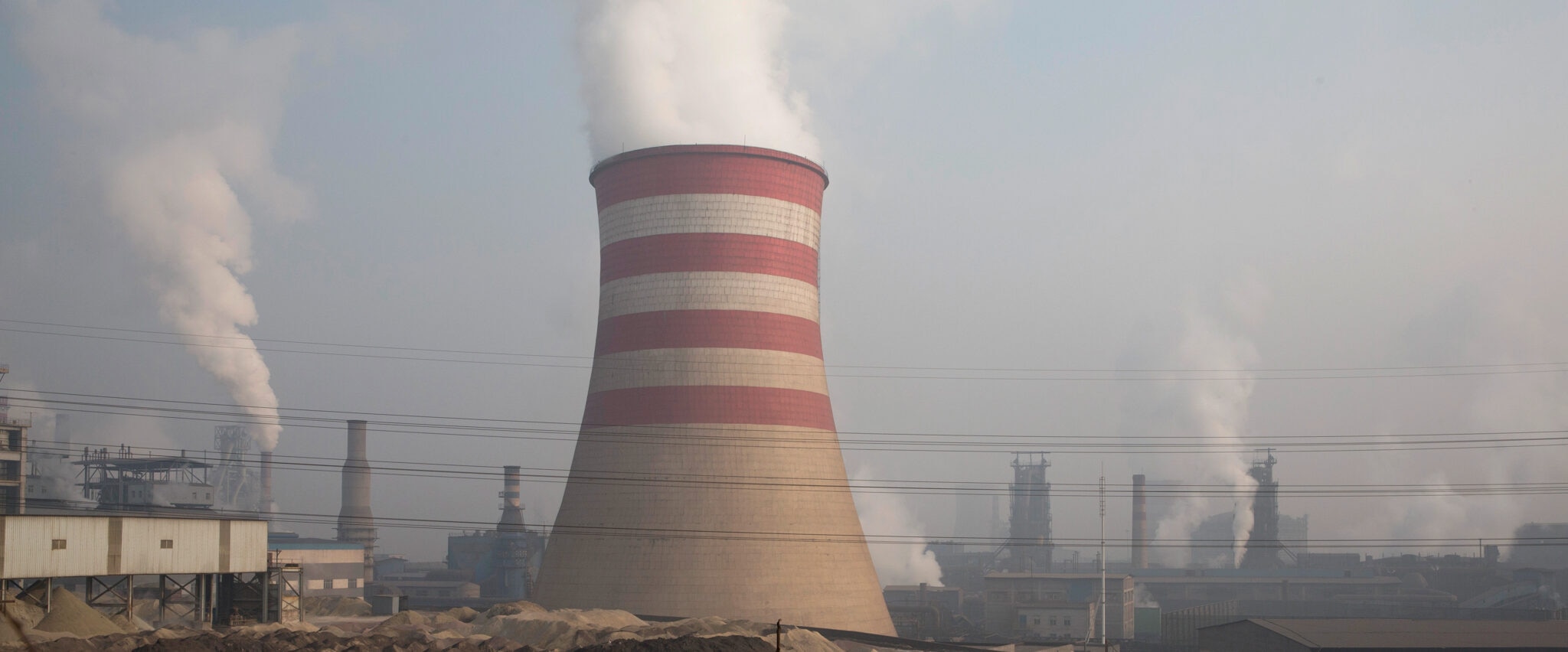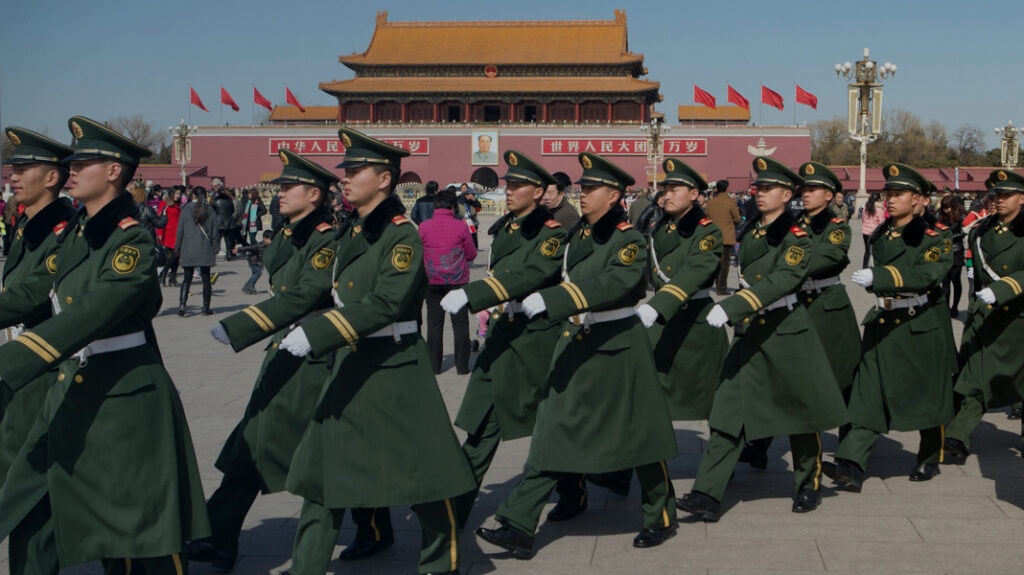Addressing China’s Environmental Destruction
The People’s Republic of China (PRC) is the world’s largest emitter of greenhouse gases; the largest source of marine debris; the worst perpetrators of illegal, unreported, and unregulated (IUU) fishing; and the world’s largest consumer of trafficked wildlife and timber products. While the Chinese people have suffered the worst environmental impacts of its actions, Beijing also threatens the global economy and global health by unsustainably exploiting natural resources and exporting its willful disregard for the environment through its One Belt One Road initiative. Tragically, the Chinese Communist Party (CCP) represses civil society and a free press, slowing changes that would benefit its citizens and people all over the world.
Watch
China dumps millions and millions of tons of plastic and trash into the oceans, overfishes other countries’ waters, destroys vast swaths of coral reef, and emits more toxic mercury into the atmosphere than any country anywhere in the world.Donald J. Trump
President of the United States
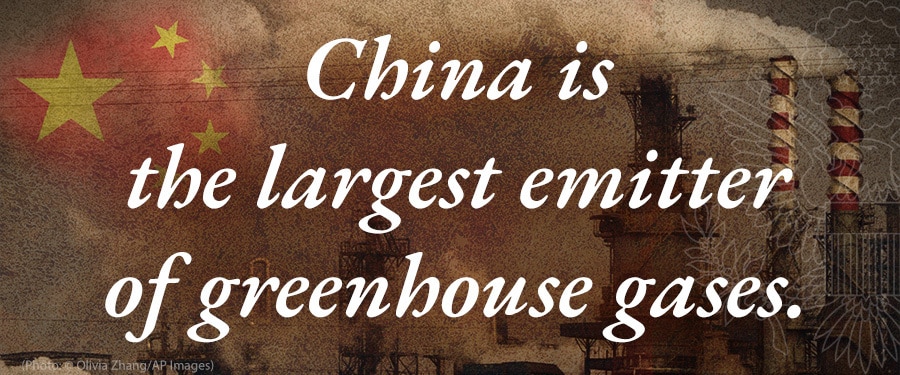
Increasing Greenhouse Gas Emissions
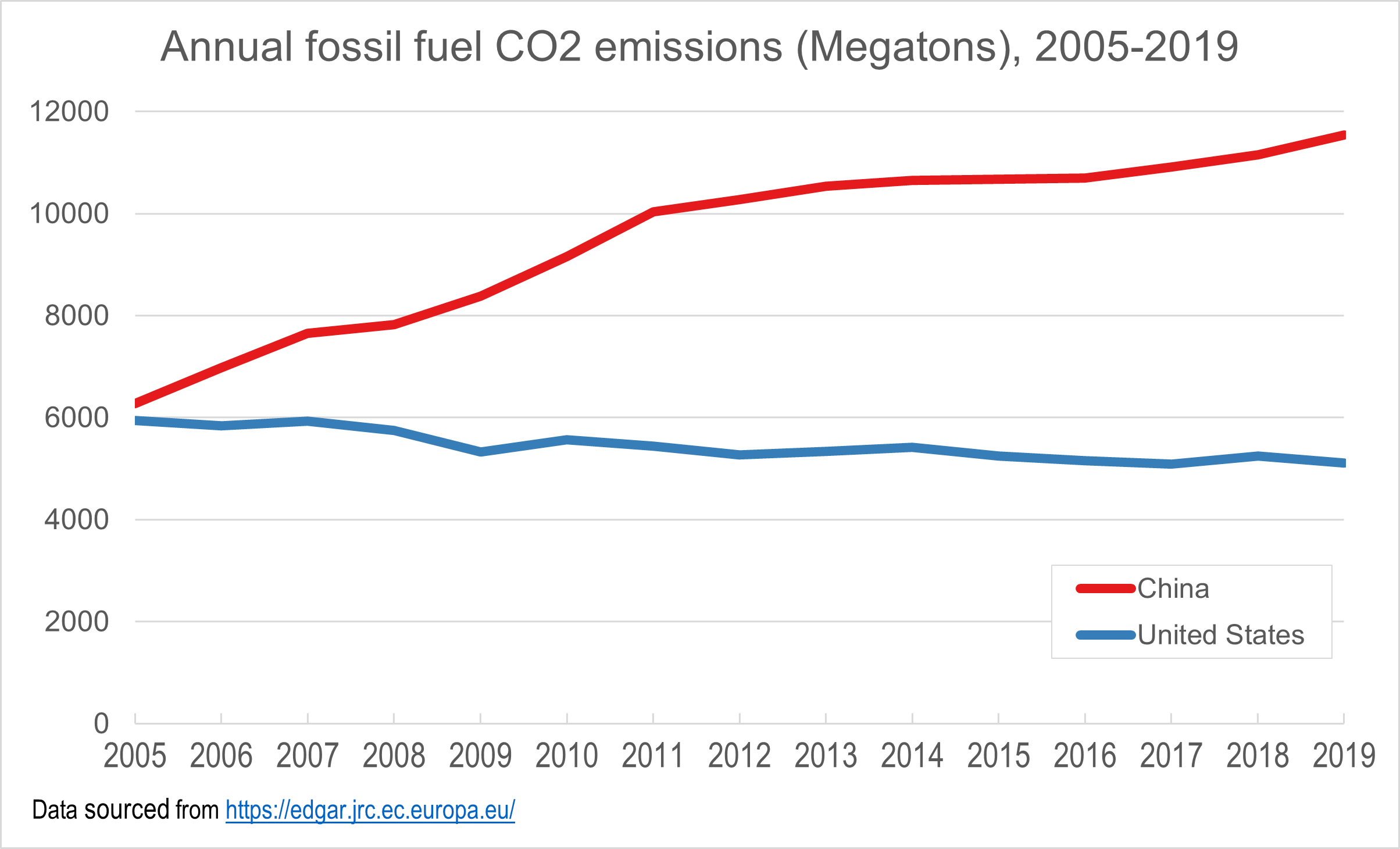 Despite claims of international environmental leadership, China’s energy-related carbon dioxide (CO2) emissions are rising. It has been the world’s largest annual greenhouse gas (GHG) emitter since 2006. China’s total energy-related emissions are twice that of the United States and nearly one third of all emissions globally. Beijing’s energy-related emissions increased more than 80 percent between 2005-2019 , while U.S. energy-related emissions have decreased by more than 15 percent. In 2019 alone, China’s energy-related CO2 emissions increased more than 3 percent, while the United States’ decreased by 2 percent. Beijing claims “developing-country” status to avoid shouldering more responsibility for reducing GHG emissions–though its per capita CO2 emissions have already reached the level of many high-income countries. China’s increasing emissions counteract the progress of many other countries around the world to reduce global emissions.
Despite claims of international environmental leadership, China’s energy-related carbon dioxide (CO2) emissions are rising. It has been the world’s largest annual greenhouse gas (GHG) emitter since 2006. China’s total energy-related emissions are twice that of the United States and nearly one third of all emissions globally. Beijing’s energy-related emissions increased more than 80 percent between 2005-2019 , while U.S. energy-related emissions have decreased by more than 15 percent. In 2019 alone, China’s energy-related CO2 emissions increased more than 3 percent, while the United States’ decreased by 2 percent. Beijing claims “developing-country” status to avoid shouldering more responsibility for reducing GHG emissions–though its per capita CO2 emissions have already reached the level of many high-income countries. China’s increasing emissions counteract the progress of many other countries around the world to reduce global emissions.
read more
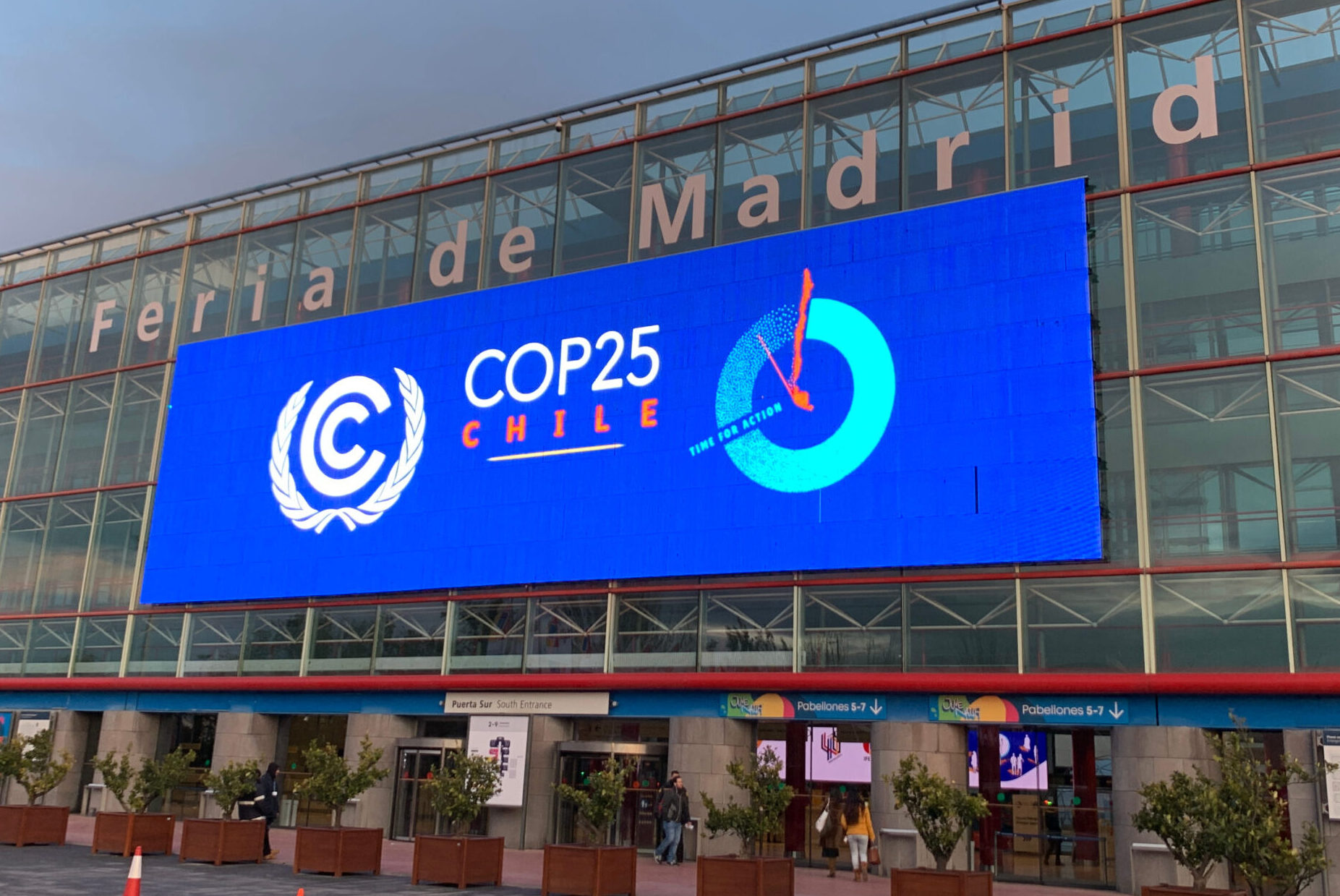
Remarks
U.S. National Statement at UNFCCC COP25

press statement
On the U.S. Withdrawal from the Paris Agreement
A Risk to the Ozone Layer
Through the Montreal Protocol, the nations of the world agreed to phase out production of substances that damage the ozone layer. But scientists identified an increase of emissions of the phased-out, ozone-depleting substance CFC-11 from Eastern China from 2014 to 2017. The United States leads the international response and continues to push China to live up to its obligations and increase its monitoring and enforcement efforts.
Too much of the Chinese Communist Party’s economy is built on willful disregard for air, land, and water quality. The Chinese people–and the world–deserve better.Michael R. Pompeo
Secretary of State
Threatening Air Quality
In 2008, U.S. diplomats installed air quality monitors on top of U.S. Embassy Beijing. The United States shared the data publicly and revealed what local residents already knew: Beijing’s air quality was dangerously worse than the Chinese government was willing to admit. That small act of transparency helped catalyze a revolution in air quality management, and Beijing has since made air quality a priority, including establishing new ambient air quality standards. Despite significant improvements in large cities, the overall level of air pollution in China remains unhealthy, and air pollution from China continues to affect downwind countries.
The Department of State works to mitigate the global threat of air pollution through diplomacy, policy leadership, and targeted foreign assistance to advance U.S. objectives and incorporate innovative technologies into diplomatic and development programs while shaping markets to support U.S. exports. The United States will continue to advance U.S. interests globally through existing international agreements on air quality, including the Convention on Long Range Transboundary Air Pollution (LRTAP) and shape efforts on air quality in the UN Environment Programme (UNEP). Further, the United States will expand our work to build capacity to improve air quality management and shape markets for U.S. technology through the Air Quality Program, which currently manages twelve large air quality grants with a combined budget of $6.6 million.
read more

AirNow | Air quality monitoring data
Greening Diplomacy Initiative’s Air Quality Monitoring Program

World’s Worst Mercury Polluter
China’s unsafe industrial processes also make it the world’s greatest emitter of mercury, a neurotoxin, and a major public health threat when allowed to pollute the air, water, and soil. China leads the world in mercury air pollution from its own dirty coal-burning power plants, as well as the plants that Chinese state-owned companies finance, build, and operate in other countries. The United States was the first country to join the 2013 Minamata Convention on Mercury, an international agreement that seeks to protect human health and the environment by comprehensively addressing mercury sources, trade, its use in products, emissions, storage, and waste. In addition, the U.S. Department of State’s Mercury Program funds projects to promote better environmental practices among artisanal and small-scale gold miners (ASGM), reducing the use of mercury used while maintaining or increasing the miners’ recovery of gold. The program also funds projects to reduce mercury emissions from coal combustion. PRC is also Party to the Minamata Convention on Mercury, yet it continues to enable its citizens to promote mercury use in ASGM in many developing countries.
Illegal Wildlife Trafficking
China is indisputably the world’s largest consumer of legal and illegal wildlife, and it was identified as a Focus Country under the Eliminate, Neutralize, and Disrupt (END) Wildlife Trafficking Act. Wildlife trafficking is a serious transnational crime that threatens security, fuels corruption, robs communities of legitimate economic livelihoods, pushes species to the brink of extinction, and spreads disease. The United States has long called for the Chinese Communist Party (CCP) to improve its behavior on combating wildlife trafficking and has secured diplomatic successes such as a near-complete ban on Chinese government-sanctioned ivory trade in 2017. The United States calls upon the CCP to permanently end sales of high-risk wildlife in wet markets, a move that would reduce the use of trafficked wildlife and wildlife products.
read more

Press statement
Call To Close Wildlife Wet Markets on the 50th Anniversary of Earth Day

report
2019 END Wildlife Trafficking Report
Driving Illegal Logging and Trade

China is the world’s largest consumer of illegal timber products. It drives illegal logging in producer countries, feeds associated trade in illegally harvested products worth $52-157 billion per year, and fuels corruption and transnational organized crime. In addition, Chinese investment in foreign infrastructure and natural resource sectors use unfair economic practices, disregard environmental and social safeguards, and target countries with weak oversight and enforcement institutions that make them susceptible to predatory Chinese extraction. These irresponsible development practices contribute to deforestation and land degradation and undercut the legitimate forest industry around the globe. China should follow the lead of the United States and others and implement a comprehensive ban on illegal timber imports.
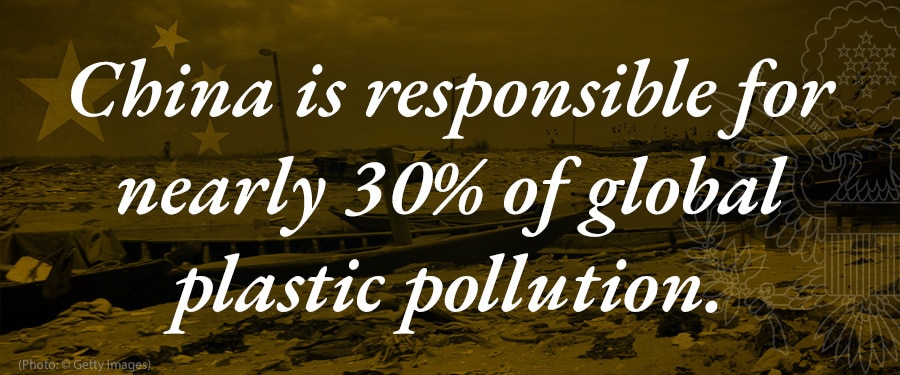
Mismanaging Plastic Waste
China is the biggest producer and exporter of plastic products, accounting for nearly 30 percent of the world’s total. A 2019 comprehensive literature review by Tianjin University estimates China is the world’s leading generator of plastic waste. At least 13 percent of China’s domestic plastic waste is unmanaged and released or dumped directly into the environment as pollution, translating into millions of tons per year. While the CCP previously supported global plastic recycling, the “National Sword” policy (which took effect in 2018) severely restricted the import of recyclable plastic scrap and disrupted the global plastic scrap trade. Now, most plastic scrap, which China had imported before 2018, is landfilled, incinerated, or processed by developing countries ill-suited to manage the sudden increase, ultimately further straining ecosystems. The United States supports environmentally sound management of all waste and scrap and promotes sustainable materials management (SMM), a systematic approach to using and reusing materials more productively over their entire life cycles.
Not-So-Green Belt and Road
China’s signature One Belt One Road Initiative (OBOR), more commonly known as the Belt and Road Initiative (BRI), aspires to create a network of enhanced overland and maritime trade routes to better link China with the world. However, implementation of BRI lacks clear environmental guidelines, safety standards, and worker protections. Many BRI-funded projects do not meet international standards, leaving countries to deal with the harmful consequences long after a project is completed. Environmental safeguards depend on the laws of host countries, and Beijing is leading nations away from developing their economies sustainably. In recent years, Chinese-backed projects on several continents have displaced local populations, negatively affected water quality, polluted adjacent land, and spoiled fragile ecosystems. Many planned Chinese infrastructure projects worldwide would do similar harm. The World Wildlife Fund (WWF) has found BRI corridors overlap with over 1,700 critical biodiversity sites and the ranges of 265 threatened species that could be adversely affected by BRI projects. A study published in Nature Sustainability suggested BRI projects may lead to “permanent environmental degradation” due to environmental harm through pollution, habitat loss, and wildlife mortality, among others.
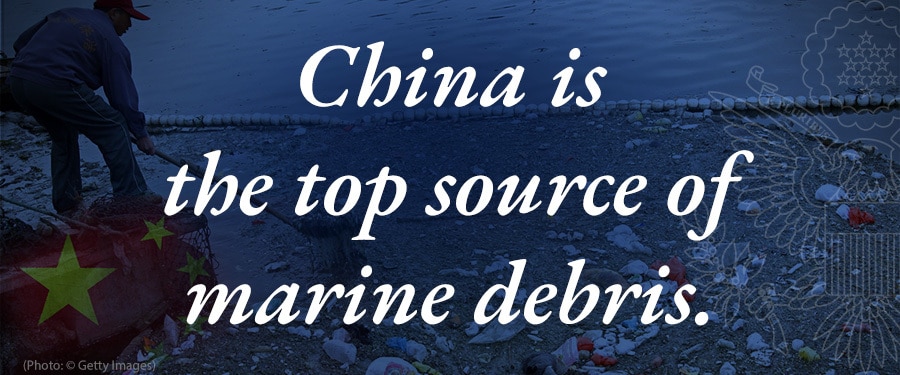
Polluting the Ocean
China is the top source of marine plastic debris. According to its own experts, China released up to one million tons of plastic waste into the ocean in 2017. The presence of plastics in the ocean costs the maritime, fishing, and tourism industries billions of dollars every year and threatens food security and public health. According to a 2020 Asia Pacific Economic Cooperation (APEC) forum report, the damage from marine debris to APEC member economies was estimated at over $11 billion in 2015 alone.
The United States proactively prevents and reduces marine debris domestically and supports such efforts internationally. The United States advocates for environmentally sound management of all waste, promotes recycling for plastic scrap, and supports innovative, market-based solutions to manage, reduce, and ultimately prevent waste and debris—including plastic waste—from polluting the environment. At Our Ocean Conferences from 2014 to 2019, the United States made 113 commitments valued at over $4.3 billion to promote sustainable fisheries, combat marine debris, and support marine science, observation, and exploration. At last year’s Our Ocean Conference, the United States announced 23 new commitments valued at $1.21 billion, including three new commitments related to marine debris.
read more

Remarks
Addressing Senate Subcommittee on the Issue of Marine Debris

media note
Reaffirming U.S. Commitments to Protecting Marine Ecosystems

fact sheet
Commitments Announced at Our Ocean 2019 Conference

Report
Update of 2009 APEC Report on Economic Costs of Marine Debris to APEC Economies
Illegal, Unreported, and Unregulated Fishing Worldwide
China is placing increased pressure on global fish stocks through unsustainable fishing practices. The Chinese Communist Party (CCP) subsidizes the world’s largest fishing fleet, including one of the largest distant-water fishing fleets operating on the high seas and in other countries’ waters. Chinese vessels routinely violate the sovereign rights and jurisdiction of other coastal States, fish without permission, and overfish licensing agreements. Despite Beijing’s claiming a “zero-tolerance” policy when it comes to these issues, the problems are widespread. China is one of the world’s worst perpetrators of illegal, unreported, and unregulated fishing (IUU), disregarding fisheries management measures. In response, the United States is developing new tools and working with international partners to ensure global fishing is legal and sustainable, while encouraging the CCP to more effectively and transparently police the activities of its fleets and hold violators accountable.
Watch
read more

Press statement
On China’s Predatory Fishing Practices in the Galápagos
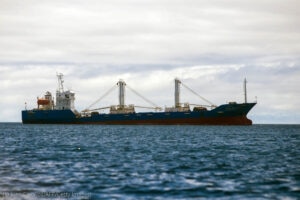
article
Chinese Fishing Fleet Threatens Galápagos Islands’ Wildlife
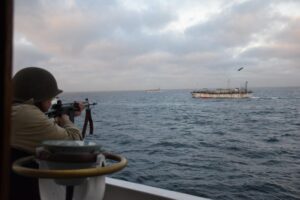
special briefing
On China’s Illegal, Unreported, and Unregulated Fishing
Unilateral Mekong Water Manipulation
China’s operation of its cascade of mega dams, opaque water management practices, and unilateral alteration of water flow in the upstream portion of the Mekong River have resulted in catastrophic consequences for its downstream neighbors. In December 2019 at the Mekong Research Symposium, researchers presented troubling evidence regarding China’s manipulation of the Mekong River’s flows for the past 25 years. Further analyses of publicly available satellite data and Mekong River Commission river height record confirmed that the greatest disruption in natural flows coincided with major dam construction and operation, exacerbated drought conditions, and contributed to immeasurable damage to fishing and agriculture. These problems are compounded by the PRC’s failure to share critical water flow data, without which Mekong region nations cannot effectively manage water resources or prepare for and mitigate the impacts of floods and droughts. The United States urges China to deliver on its recent commitment to share year-round water data and work in concert with the Mekong River Commission (MRC) to capitalize on existing partnerships and platforms for data sharing, including the MRC’s Data and Information Sharing Platform and the Mekong Water Data Initiative (MWDI).
Watch
read more

media note
Joint Statement on the Eleventh Ministerial Meeting of the Lower Mekong Initiative
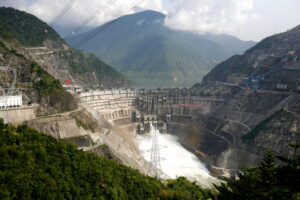
report
How China Turned Off the Tap on the Mekong River

website
Mekong-U.S. Partnership
–

website
Mekong Water Data Initiative (MWDI)
For further information and resources, visit the website of the Bureau of Oceans and International Environmental and Scientific Affairs (OES). For press inquiries, contact OES-PA-DG@state.gov.
